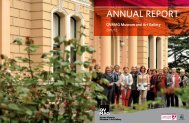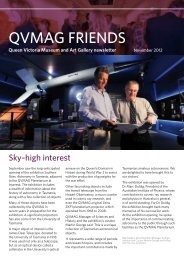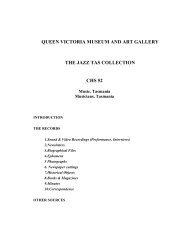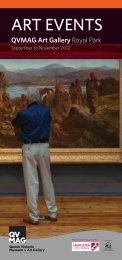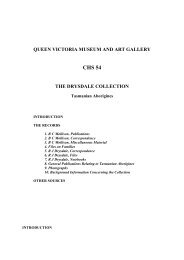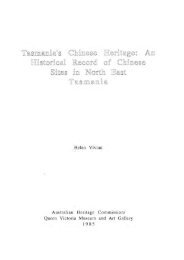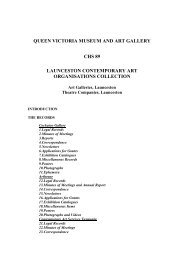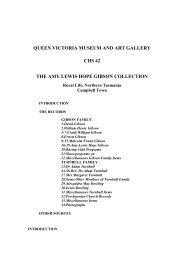Scrimshaw Collection Guide - Queen Victoria Museum and Art Gallery
Scrimshaw Collection Guide - Queen Victoria Museum and Art Gallery
Scrimshaw Collection Guide - Queen Victoria Museum and Art Gallery
Create successful ePaper yourself
Turn your PDF publications into a flip-book with our unique Google optimized e-Paper software.
<strong>Scrimshaw</strong> <strong>Collection</strong> <strong>Guide</strong><br />
Introduction<br />
<strong>Scrimshaw</strong> is sometimes called the ancient art of the mariner. It is the craft of carving decoration onto the<br />
teeth <strong>and</strong> bones of marine life, but most commonly whales. It is also an art that reflects a period when the<br />
ocean was seen as an endless resource for exploitation. The <strong>Queen</strong> <strong>Victoria</strong> <strong>Museum</strong> <strong>and</strong> <strong>Art</strong> <strong>Gallery</strong><br />
houses one of the most comprehensive <strong>and</strong> diverse collections of 19th century scrimshaw in Australia.<br />
Significance/collection rationale<br />
The scrimshaw collection held by the <strong>Museum</strong> comes from a number of sources. A significant part of the<br />
collection can be attributed to the photographer <strong>and</strong> collector, JW Beattie whose museum was purchased by<br />
the <strong>Queen</strong> <strong>Victoria</strong> <strong>Museum</strong> <strong>and</strong> <strong>Art</strong> <strong>Gallery</strong> in 1927. He sourced items of scrimshaw from Hobart-based<br />
collectors including Sir William Crowther <strong>and</strong> the Bayley family of Runnymede. Recent additions to the<br />
scrimshaw collection include works by artist Christian Ahern for exhibition at the <strong>Queen</strong> <strong>Victoria</strong> <strong>Museum</strong> <strong>and</strong><br />
<strong>Art</strong> <strong>Gallery</strong> in 1989.<br />
The strength of this collection is its diversity. It features objects that are both functional <strong>and</strong> decorative.<br />
Walking sticks with clenched fist h<strong>and</strong>les, table ornaments such as spoons, forks <strong>and</strong> eggcups <strong>and</strong> desk sets<br />
of Tasmanian timbers with whalebone feature prominently. Of particular interest are the powder horns, used<br />
to load muskets with gunpowder for firing. Some of these accessories are decorated with symbols of love,<br />
war, <strong>and</strong> families at home. Others feature snippets of popular culture periodicals, perhaps the only<br />
inspiration available during long periods in isolated areas. <strong>Scrimshaw</strong> provides tantalising glimpses into life<br />
on the oceanic transport highways of the pre 20th century world.<br />
Discussion<br />
The whaling industry played an important part in 19th century Tasmanian life, particularly so in Hobart, one<br />
of the deepest ports in the southern hemisphere. Whaling was undertaken primarily for the extraction of<br />
whale oil <strong>and</strong> bone. Shore-based whaling stations were established throughout the colony. Hobart became a<br />
busy <strong>and</strong> prosperous port hosting vessels from the United States, Britain, France <strong>and</strong> New Zeal<strong>and</strong>. Extant<br />
scrimshaw collections in Tasmania reflect these diverse origins. Flags, flora, fauna <strong>and</strong> depictions of events<br />
in world history give clues as to the nationality of the creator.<br />
The whaleteeth or bone associated with scrimshaw was meticulously polished. Images were pinpricked onto<br />
the surface of the tooth or bone. Similar to a join-the-dots puzzle, lines were incised to create an image.<br />
Pigments were used to highlight the engraving. <strong>Scrimshaw</strong>’s uniqueness is that it is not just pictorial.<br />
Whaleteeth or bone can be carved in relief or to create forms in its own right; tools, walking sticks, cutlery<br />
<strong>and</strong> fashion accessories to name a few. This particular scrimshaw collection features a unique commercial<br />
product of the whaling industry: Edwardian whalebone corset supports.<br />
In 1875 the Hobart-based Mercury noted the inclusion of timber <strong>and</strong> whalebone cruet st<strong>and</strong> for the<br />
Melbourne <strong>and</strong> Philadelphia exhibitions:<br />
Mercury 24 June 1875<br />
‘SPECIMENS OF TURNERY… a cruet st<strong>and</strong> <strong>and</strong> egg st<strong>and</strong> combined, made of turned wood, polished, <strong>and</strong><br />
valued at 10 pounds. The various cups, salt cellars, <strong>and</strong> pepper bottles are carved of whale’s teeth, in an<br />
exquisite tulip pattern. The h<strong>and</strong>le is also of carved whale’s teeth representing leaves. The maker is a<br />
mechanic named P.O. Carlson, a Danish immigrant, <strong>and</strong> he has executed the work in his leisure hours, or,<br />
as he terms it “c<strong>and</strong>le work,” after his day’s labour is over for the Government at Port <strong>Art</strong>hur, where he is<br />
employed …’<br />
In the latter half of the 19th century, the whaling industry in Tasmania came to a close. Items of scrimshaw<br />
subsequently became of interest to collectors. In Tasmania, two well-known identities Sir William Crowther<br />
<strong>and</strong> the photographer JW Beattie became prominent collectors of scrimshaw. They bought, sold, donated<br />
<strong>and</strong> traded items of scrimshaw with each other <strong>and</strong> public institutions. The <strong>Queen</strong> <strong>Victoria</strong> <strong>Museum</strong> <strong>and</strong> <strong>Art</strong><br />
<strong>Gallery</strong> acquired Beattie’s large museum including a highly diverse scrimshaw collection in 1927. A year later<br />
a visiting journalist wrote about the scrimshaw display at the <strong>Museum</strong>’s Royal Park site:<br />
QVMAG History <strong>Collection</strong> <strong>Guide</strong>—<strong>Scrimshaw</strong> (Kim Simpson), October 2006 Page 1 of 24<br />
© <strong>Queen</strong> <strong>Victoria</strong> <strong>Museum</strong> <strong>and</strong> <strong>Art</strong> <strong>Gallery</strong>
Launceston Examiner 18 May 1928<br />
Priceless Relics: Historical <strong>Collection</strong> A Tour Around the Cases (No.3)<br />
‘… Just how this name (scrimshaw) came about nobody seems to know <strong>and</strong> the best authorities content<br />
themselves with a general description of the finished work without making any attempt at solving the problem<br />
of the word’s origin <strong>and</strong> some think it is the name of some sailor called <strong>Scrimshaw</strong> who first started the craze<br />
going. Others trace it to the American Indian <strong>and</strong> so the guesses go on, though for our purpose it is enough<br />
to know by means of ground out nails knives <strong>and</strong> even bits of hoop-iron cunningly worked to a cutting edge<br />
these men simulated the ivory engraver’s art …’<br />
The Donors: Some biographical information<br />
JW Beattie (1859–1930)<br />
James Watt Beattie was born in Scotl<strong>and</strong> <strong>and</strong> emigrated to Tasmania with his parents in 1878. He was a<br />
well-known environmentalist, photographer <strong>and</strong> inveterate collector. Beattie had a passion for convictism,<br />
especially Port <strong>Art</strong>hur. He travelled Tasmania visiting areas not photographed or documented before.<br />
Beattie’s fervour has furnished the <strong>Queen</strong> <strong>Victoria</strong> <strong>Museum</strong> <strong>and</strong> <strong>Art</strong> <strong>Gallery</strong> with a unique series of<br />
collections representing early European Tasmania.<br />
HC Abbott (1876–1965)<br />
Henry Charles Abbott was born in Ballarat in <strong>Victoria</strong> <strong>and</strong> came to Tasmania as a young boy. His family<br />
owned Phoenix Brewery in Paterson Street Launceston, which in the late 1880s began producing soft drinks<br />
<strong>and</strong> became known as Abbott’s Pty Ltd. Mr Abbott was interested in art <strong>and</strong> music <strong>and</strong> gave generously to<br />
various charities through several trust funds he established in his name. The HC Abbott Hall in St Georges<br />
Square, Launceston was built with funds donated by Abbott.<br />
CG Ryan (1866–1954)<br />
Cecil Godfrey Ryan was born in Brighton, Melbourne in 1866. His sister was the well-known Australian artist<br />
Ellis Rowan. Ryan was a graduate of the University of Melbourne <strong>and</strong> came to Tasmania to live in the early<br />
1900s. He established the Pioneer mine in the north-east of the State <strong>and</strong> had a keen interest in<br />
ethnography, history <strong>and</strong> photography. He died in Launceston in 1954, aged 88 years.<br />
Significant items in this collection:<br />
Rocky Whelan Club<br />
John ‘Rocky’ Whelan, a convict, served part of his sentence at both Norfolk<br />
Isl<strong>and</strong> <strong>and</strong> at Port <strong>Art</strong>hur penal settlements. He escaped from a labour gang<br />
in the 1840s, leading a life of robbery <strong>and</strong> violence. Whelan’s most notorious<br />
hideout was on the slopes of Mount Wellington in Hobart; a cave on the<br />
mountain still known to this day as Rocky Whelan’s Cave. This club was<br />
found in one of Whelan’s hideouts.<br />
Beattie <strong>Collection</strong> QVM 1983.H.39<br />
Henning Drinking Cup<br />
Captain Shurlock Henning (1829–1898) of the 88th Regiment, later<br />
Lieutenant General, carved an inscription on this cup in November 1855.<br />
Henning served through the Crimean War <strong>and</strong> the Indian Mutiny <strong>and</strong> was<br />
later awarded a Comm<strong>and</strong>er of the Order of the Bath. It is not known how the<br />
cup came to be in Tasmania but it can first be attributed to a Mrs McRodden<br />
of the Sportsman’s Hall Hotel in Charles Street, Launceston, in the 1880s.<br />
Purchased 1941 from Mr HC Abbott QVM 1985.H.23<br />
QVMAG History <strong>Collection</strong> <strong>Guide</strong>—<strong>Scrimshaw</strong> (Kim Simpson), October 2006 Page 2 of 24<br />
© <strong>Queen</strong> <strong>Victoria</strong> <strong>Museum</strong> <strong>and</strong> <strong>Art</strong> <strong>Gallery</strong>
Bayley St<strong>and</strong> with cups<br />
This display st<strong>and</strong> with carved eggcups was possibly the work of Captain<br />
James Bayley (1823–1894) of the residence Runnymede in north Hobart in<br />
southern Tasmania. Bayley, a native of Essex, played an important part in the<br />
colony’s whaling industry. He is said to have had a lathe on board his vessel<br />
for creating turned <strong>and</strong> carved pieces of scrimshaw. This particular object is<br />
provenanced to the JW Beattie collection.<br />
Beattie <strong>Collection</strong> QVM 1985.H.73<br />
Captain Kelly’s walking stick<br />
Captain James Kelly (1791–1859), a prominent maritime identity in early<br />
Tasmanian maritime history, owned this walking stick. He circumnavigated<br />
Tasmania in an open whaleboat <strong>and</strong> was the first recorded European<br />
explorer of Macquarie Harbour on the west coast. Based upon his<br />
recommendation, a timber station was established by the government soon<br />
after his visit. There are many l<strong>and</strong>marks in Tasmania named after Kelly,<br />
including Kelly’s Steps behind Salamanca Place in Hobart.<br />
Beattie <strong>Collection</strong> QVM 1985.H.93<br />
Powder horns<br />
The <strong>Queen</strong> <strong>Victoria</strong> <strong>Museum</strong> <strong>and</strong> <strong>Art</strong> <strong>Gallery</strong>’s scrimshaw collection includes<br />
a highly unique collection of powder horns. Animal horns have been<br />
employed as receptacles for centuries. Because they are hollow <strong>and</strong> were<br />
relatively easy to obtain they provided good storage for gunpowder <strong>and</strong> often<br />
decorated with regimental emblems. Little is known about the provenance<br />
<strong>and</strong> markings adorning the powder horns in this collection.<br />
QVMAG History <strong>Collection</strong> <strong>Guide</strong>—<strong>Scrimshaw</strong> (Kim Simpson), October 2006 Page 3 of 24<br />
© <strong>Queen</strong> <strong>Victoria</strong> <strong>Museum</strong> <strong>and</strong> <strong>Art</strong> <strong>Gallery</strong>
Items in this collection:<br />
Walking Stick<br />
Carved whalebone, ivory <strong>and</strong> animal horn. Features black <strong>and</strong> white striped<br />
inlay with an octagonal head.<br />
Beattie <strong>Collection</strong> QVM 1983.H.128<br />
Walking Stick<br />
Carved ivory, blackwood, silver, animal horn <strong>and</strong> brass. Clenched fist at top.<br />
This walking stick belonged to John Price (1808–1857). He was the Police<br />
Magistrate at Hobart Town between 1838 <strong>and</strong> 1845.<br />
Beattie <strong>Collection</strong> QVM 1983.H.129<br />
Drinking Horn or Cup<br />
Carved animal horn. Turned base. Belonged to Captain James Kelly (1791–<br />
1859).<br />
Beattie <strong>Collection</strong> QVM 1983.H.155<br />
Whaletooth<br />
Decorated whaletooth. Two boats, one French <strong>and</strong> one English.<br />
Beattie <strong>Collection</strong> QVM 1985.H.0016<br />
Jawbone, Part<br />
Decorated half jaw bone of whale. Portrait of a man <strong>and</strong> a woman under an<br />
arch of foliage. ‘THE TWO LOVERS’ at bottom of image. Image in dot<br />
format.<br />
Beattie <strong>Collection</strong> QVM 1985.H.18<br />
QVMAG History <strong>Collection</strong> <strong>Guide</strong>—<strong>Scrimshaw</strong> (Kim Simpson), October 2006 Page 4 of 24<br />
© <strong>Queen</strong> <strong>Victoria</strong> <strong>Museum</strong> <strong>and</strong> <strong>Art</strong> <strong>Gallery</strong>
Desk Set<br />
Decorated <strong>and</strong> carved whaletooth, whalebone, wood <strong>and</strong> metal. The<br />
whalebone back is decorated with a ship <strong>and</strong> the two whale teeth with a<br />
man <strong>and</strong> a woman in Scottish dress. Base of Huon pine.<br />
Beattie <strong>Collection</strong> QVM 1985.H.20<br />
Drinking Horn or Cup<br />
Carved <strong>and</strong> decorated animal horn with cork base. Made by Captain S<br />
Henning (1829–1898) <strong>and</strong> used as a drinking cup. Inscribed as follows:<br />
‘L<strong>and</strong>d in Turkey 19 th Apr 1854. L<strong>and</strong>d on the Crimea 14 th Sept 1854. The<br />
Battl of Alma 20 th Septr 1854 The taken of Ballaklava 27 th of Septr 54. The<br />
Batl of Ballaklava 26 th Oct 54. The Bat of Inkermann 5 th Novbr 54 The First<br />
Siege that opened on Sebastapol was WAS ON 17 TH Oct 54. Sebastapol<br />
captured 8 th Sept 55 The Armistice held in March 56 This horn was found<br />
where the explosion took place 16 th Novr 55. S.Henning Capt 88 th Regt.’<br />
Seven arrows featured at bottom of cup.<br />
Purchased 1941 from Mr HC Abbott QVM 1985.H.23<br />
Powder Horn<br />
Decorated animal horn. Inscribed as follows: ‘HIS MOST GRACIOUS<br />
MAJESTY/GEORGE IV, THE RIGHT HON VISC NELSON/VICE ADMIRAL<br />
OF THE WHITE, John Jackson R.A.’ Varnished.<br />
Beattie <strong>Collection</strong> QVM 1985.H.24<br />
Powder Horn<br />
Decorated animal horn. Sun, boat with US flag, crown encircled by wreath,<br />
vase of flowers, bird, fish, heart with ‘LOVE’ inscribed in centre.<br />
QVM 1985.H.25<br />
QVMAG History <strong>Collection</strong> <strong>Guide</strong>—<strong>Scrimshaw</strong> (Kim Simpson), October 2006 Page 5 of 24<br />
© <strong>Queen</strong> <strong>Victoria</strong> <strong>Museum</strong> <strong>and</strong> <strong>Art</strong> <strong>Gallery</strong>
Powder Horn<br />
Decorated animal horn. Crown, boat <strong>and</strong> soldier illustrations. Scalloped lip.<br />
Donation C G Ryan QVM 1985.H.26<br />
Powder Horn<br />
Decorated animal horn. Inscribed as follows: ‘SIC FORTI HOBARTIA<br />
GREVIT’. Translation: ‘Thus in Strength Does Hobart Grow’<br />
QVM 1985.H.28<br />
Jawbone, Part<br />
Decorated half jaw bone of whale with eight teeth. Portrait of a man<br />
surrounded by a wreath of wheat ears. The portrait is possibly Alfred, Duke<br />
of Edinburgh who visited the Australian colonies in 1868.<br />
Beattie <strong>Collection</strong> QVM 1985.H.29<br />
Jawbone, Part<br />
QVMAG History <strong>Collection</strong> <strong>Guide</strong>—<strong>Scrimshaw</strong> (Kim Simpson), October 2006 Page 6 of 24<br />
© <strong>Queen</strong> <strong>Victoria</strong> <strong>Museum</strong> <strong>and</strong> <strong>Art</strong> <strong>Gallery</strong>
Decorated half jaw bone of whale with eight teeth. Portrait of a man in<br />
medieval costume. Another of two men one with arm outstretched. Both<br />
images have been coloured black. Faint drawing of another man.<br />
Beattie <strong>Collection</strong> QVM 1985.H.30<br />
Jawbone, Part<br />
Decorated half jaw bone of whale with 10 teeth. Portrait of a naked man<br />
being eaten by a vulture.<br />
Beattie <strong>Collection</strong> QVM 1985.H.31<br />
Jawbone, Part<br />
Decorated half jaw bone of whale. Portrait of a man holding a woman’s<br />
h<strong>and</strong>. Engraving of plant above. Both images in dot format.<br />
Beattie <strong>Collection</strong> QVM 1985.H.32<br />
QVMAG History <strong>Collection</strong> <strong>Guide</strong>—<strong>Scrimshaw</strong> (Kim Simpson), October 2006 Page 7 of 24<br />
© <strong>Queen</strong> <strong>Victoria</strong> <strong>Museum</strong> <strong>and</strong> <strong>Art</strong> <strong>Gallery</strong>
Right Angle Measuring Square<br />
Carved whalebone with Masonic Lodge logo on one side <strong>and</strong> ‘??D’ on the<br />
reverse.<br />
Beattie <strong>Collection</strong> QVM 1985.H.33<br />
Baton<br />
Decorated whalebone baton with metal head <strong>and</strong> base. Leather strap tied to<br />
base.<br />
Purchased 1971 QVM 1985.H.35<br />
Fid<br />
Carved whalebone tool for separating rope str<strong>and</strong>s.<br />
Beattie <strong>Collection</strong> QVM 1985.H.36<br />
Fid/Club<br />
Carved whalebone tool for separating rope str<strong>and</strong>s. Six rings engraved<br />
around top.<br />
Beattie <strong>Collection</strong> QVM 1985.H.37<br />
Tool, Splicing<br />
Carved whalebone tool for splicing rope.<br />
Beattie <strong>Collection</strong> QVM 1985.H.38<br />
QVMAG History <strong>Collection</strong> <strong>Guide</strong>—<strong>Scrimshaw</strong> (Kim Simpson), October 2006 Page 8 of 24<br />
© <strong>Queen</strong> <strong>Victoria</strong> <strong>Museum</strong> <strong>and</strong> <strong>Art</strong> <strong>Gallery</strong>
Tool, Splicing<br />
Carved whalebone tool for splicing rope.<br />
Beattie <strong>Collection</strong> QVM 1985.H.39<br />
Tool, Splicing<br />
Carved whalebone tool for splicing rope.<br />
Beattie <strong>Collection</strong> QVM 1985.H.40<br />
Serving Mallet<br />
Carved whalebone.<br />
Beattie <strong>Collection</strong> QVM 1985.H.41<br />
Boat builder’s Chisel<br />
Carved whalebone<br />
Beattie <strong>Collection</strong> QVM 1985.H.42<br />
Seam Rubber<br />
Carved whalebone tool used by sailmakers in the manufacture of canvas<br />
sails. It smooths seams of sails after sewing.<br />
Beattie <strong>Collection</strong> QVM 1985.H.43<br />
Whaletooth<br />
Decorated whaletooth. Portrait of Britannia crowning a woman with a laurel<br />
wreath.<br />
Beattie <strong>Collection</strong> QVM 1985.H.45<br />
QVMAG History <strong>Collection</strong> <strong>Guide</strong>—<strong>Scrimshaw</strong> (Kim Simpson), October 2006 Page 9 of 24<br />
© <strong>Queen</strong> <strong>Victoria</strong> <strong>Museum</strong> <strong>and</strong> <strong>Art</strong> <strong>Gallery</strong>
Whaletooth<br />
Polished whale tooth.<br />
Beattie <strong>Collection</strong> QVM 1985.H.46<br />
Whaletooth<br />
Polished whale tooth.<br />
Beattie <strong>Collection</strong> QVM 1985.H.47<br />
Whaletooth<br />
Decorated whaletooth. Portrait of man in naval clothing with cap in one<br />
h<strong>and</strong> <strong>and</strong> bag in the other. Ship in background. ‘1836’ scratched lightly<br />
under image.<br />
Beattie <strong>Collection</strong> QVM 1985.H.52<br />
Whaletooth<br />
Decorated whaletooth. Portrait of a woman possibly in Dutch costume with<br />
h<strong>and</strong> in pocket.<br />
Beattie <strong>Collection</strong> QVM 1985.H.53<br />
Whaletooth<br />
Decorated whaletooth. Portrait of a woman with three-quarter figure. Long<br />
hair.<br />
Beattie <strong>Collection</strong> QVM 1985.H.55<br />
Whaletooth<br />
Decorated whaletooth. Portrait of a man <strong>and</strong> woman holding h<strong>and</strong>s.<br />
QVMAG History <strong>Collection</strong> <strong>Guide</strong>—<strong>Scrimshaw</strong> (Kim Simpson), October 2006 Page 10 of 24<br />
© <strong>Queen</strong> <strong>Victoria</strong> <strong>Museum</strong> <strong>and</strong> <strong>Art</strong> <strong>Gallery</strong>
Beattie <strong>Collection</strong> QVM 1985.H.56<br />
Whaletooth<br />
Decorated whaletooth. Image of a plant in a pot.<br />
Beattie <strong>Collection</strong> QVM 1985.H.57<br />
Whaletooth<br />
Decorated whale tooth. Faint image of a house.<br />
Beattie <strong>Collection</strong> QVM 1985.H.58<br />
Whaletooth<br />
Decorated whaletooth. Portrait of a man riding a donkey. ‘ENGLAND’<br />
inscribed on donkey. Man in striped trousers at rear of image.<br />
Beattie <strong>Collection</strong> QVM 1985.H.59<br />
Whaletooth<br />
Decorated whaletooth. Portrait of woman in full-length dress <strong>and</strong> long hair.<br />
QVMAG History <strong>Collection</strong> <strong>Guide</strong>—<strong>Scrimshaw</strong> (Kim Simpson), October 2006 Page 11 of 24<br />
© <strong>Queen</strong> <strong>Victoria</strong> <strong>Museum</strong> <strong>and</strong> <strong>Art</strong> <strong>Gallery</strong>
Beattie <strong>Collection</strong> QVM 1985.H.60<br />
Whaletooth<br />
Decorated whaletooth. Portrait of a woman in dress <strong>and</strong> hat. Back of<br />
whaletooth is inscribed ‘EW’ above three intertwined fish.<br />
QVM 1985.H.61<br />
Whaletooth<br />
Decorated whaletooth. Portrait in red <strong>and</strong> black of a Scottish soldier in<br />
highl<strong>and</strong> dress <strong>and</strong> <strong>and</strong> woman holding staff in her right h<strong>and</strong>. Woman<br />
wearing dress with labels inscribed as follows: ‘BELLS LIFE’, ‘POST’,<br />
‘GAZETT’ (sic), ‘HERALD’ ‘ARGUS’. Pair to QVM.1985.H.63<br />
Purchased 1928 QVM 1985.H.62<br />
Whaletooth<br />
Decorated whaletooth. Portrait in red <strong>and</strong> black of English soldier with<br />
woman in full-length dress <strong>and</strong> red ribbon around her neck. Pair to QVM<br />
1985.H.62.<br />
Purchased 1928 QVM 1985.H.63<br />
Whaletooth<br />
Decorated whaletooth. Portrait of a woman embracing a cupid. One of a<br />
pair to QVM 1985.H.65<br />
Purchased 1928 QVM 1985.H.64<br />
Whaletooth<br />
Decorated whaletooth. Portrait of a bedraggled woman with bare feet. One<br />
of a pair to QVM 1985.H.64<br />
Purchased 1928 QVM 1985.H.65<br />
Whaletooth<br />
Decorated whaletooth. Portrait of a man holding a letter. Bookcase <strong>and</strong><br />
QVMAG History <strong>Collection</strong> <strong>Guide</strong>—<strong>Scrimshaw</strong> (Kim Simpson), October 2006 Page 12 of 24<br />
© <strong>Queen</strong> <strong>Victoria</strong> <strong>Museum</strong> <strong>and</strong> <strong>Art</strong> <strong>Gallery</strong>
clock in background. One of a pair to QVM.1985.H.67<br />
Purchased 1928 QVM 1985.H.66<br />
Whaletooth<br />
Decorated whaletooth. Portrait of a woman in a dress with three layers. One<br />
of a pair to QVM.1985.H.66<br />
Purchased 1928 QVM 1985.H.67<br />
Whaletooth<br />
Decorated whaletooth. Portrait of a woman lifting another woman from the<br />
water. One of a pair to QVM 1985.H.69<br />
Beattie <strong>Collection</strong> QVM 1985.H.68<br />
Whaletooth<br />
Decorated whaletooth. Portrait of a seated man holding a gun next to a<br />
seated woman with black dog in front. One of a pair to QVM 1985.H.68.<br />
Beattie <strong>Collection</strong> QVM 1985.H.69<br />
Desk Set<br />
Carved <strong>and</strong> decorated whaletooth, whalebone, wood <strong>and</strong> metal. The fretted<br />
whalebone back is decorated with flags of the Honourable East India<br />
Company <strong>and</strong> the two whale teeth with women in late 1820s dress.<br />
Purchased 1940 from Mrs E Fisher Launceston QVM 1985.H.70<br />
Basket<br />
Whalebone <strong>and</strong> wood, oval-shaped open basket. Design features two rows<br />
QVMAG History <strong>Collection</strong> <strong>Guide</strong>—<strong>Scrimshaw</strong> (Kim Simpson), October 2006 Page 13 of 24<br />
© <strong>Queen</strong> <strong>Victoria</strong> <strong>Museum</strong> <strong>and</strong> <strong>Art</strong> <strong>Gallery</strong>
of vertical eye shapes between horizontal borders. Wooden base.<br />
Beattie <strong>Collection</strong> QVM 1985.H.71<br />
Basket<br />
Whalebone <strong>and</strong> wood, open oval-shaped basket. Design features two rows<br />
of vertical eye shapes between horizontal borders. Eyes have horizontal<br />
line through middle. Top <strong>and</strong> bottom has scalloped edge. Wooden base.<br />
Beattie <strong>Collection</strong> QVM 1985.H.72<br />
St<strong>and</strong>, Egg Cup<br />
Made of carved whalebone <strong>and</strong> Tasmanian woods including blackwood <strong>and</strong><br />
huon pine. Possibly made by Captain James Bayley (1823–1894).<br />
Beattie <strong>Collection</strong> QVM 1985.H.73<br />
Spoon<br />
Carved whalebone. Used as a mustard spoon.<br />
Beattie <strong>Collection</strong> QVM 1985.H.74a<br />
Spoon<br />
Carved whalebone. Used as a mustard spoon.<br />
Beattie <strong>Collection</strong> QVM 1985.H.74b<br />
Spoon<br />
QVMAG History <strong>Collection</strong> <strong>Guide</strong>—<strong>Scrimshaw</strong> (Kim Simpson), October 2006 Page 14 of 24<br />
© <strong>Queen</strong> <strong>Victoria</strong> <strong>Museum</strong> <strong>and</strong> <strong>Art</strong> <strong>Gallery</strong>
Carved whalebone. Used as a salt spoon.<br />
Beattie <strong>Collection</strong> QVM 1985.H.75a<br />
Spoon<br />
Carved whalebone. Used as a salt spoon.<br />
Beattie <strong>Collection</strong> QVM 1985.H.75b<br />
Spoon<br />
Carved whalebone. Used as a salt spoon.<br />
Beattie <strong>Collection</strong> QVM 1985.H.75c<br />
Bodkin<br />
Carved whalebone <strong>and</strong> steel. Bodkins were used for threading cord, tape or<br />
ribbon through holes or castings. The sharp point of the bodkin could be<br />
used for making holes in fabric or embroidery.<br />
Beattie <strong>Collection</strong> QVM 1985.H.77<br />
Pincushion<br />
Carved whalebone pincushion base. Decoration features two heart shapes<br />
beside one another. Top has teethed edge. Missing cushion for interior.<br />
Beattie <strong>Collection</strong> QVM 1985.H.78<br />
Napkin Ring<br />
Carved whalebone highly polished circular ring.<br />
Beattie <strong>Collection</strong> QVM 1985.H.79<br />
Napkin Ring<br />
Carved whalebone highly polished circular ring.<br />
QVMAG History <strong>Collection</strong> <strong>Guide</strong>—<strong>Scrimshaw</strong> (Kim Simpson), October 2006 Page 15 of 24<br />
© <strong>Queen</strong> <strong>Victoria</strong> <strong>Museum</strong> <strong>and</strong> <strong>Art</strong> <strong>Gallery</strong>
Beattie <strong>Collection</strong> QVM 1985.H.80<br />
Napkin Ring<br />
Carved whalebone highly polished circular ring.<br />
Beattie <strong>Collection</strong> QVM 1985.H.81<br />
Spoon<br />
Carved whalebone. Used as a mustard spoon.<br />
Beattie <strong>Collection</strong> QVM 1985.H.82<br />
Game, part<br />
Carved whale tooth cylindrical in shape. Appears to be a dice thrower<br />
turned on a machine. Rings around interior <strong>and</strong> exterior.<br />
Beattie <strong>Collection</strong> QVM 1985.H.83<br />
Model, Architect’s<br />
Whalebone <strong>and</strong> wood model. Base is wooden with carved whalebone fence<br />
at front. Model has three walls <strong>and</strong> two pillars at each end.<br />
Beattie <strong>Collection</strong> QVM 1985.H.84<br />
Tusk<br />
Small polished tusk carved with eight sides.<br />
Beattie <strong>Collection</strong> QVM 1985.H.89<br />
Club<br />
Long polished walrus tooth used as clubbing device. Hole in narrow end of<br />
QVMAG History <strong>Collection</strong> <strong>Guide</strong>—<strong>Scrimshaw</strong> (Kim Simpson), October 2006 Page 16 of 24<br />
© <strong>Queen</strong> <strong>Victoria</strong> <strong>Museum</strong> <strong>and</strong> <strong>Art</strong> <strong>Gallery</strong>
tooth.<br />
Purchased 1970 from Mr A Sims, QVM 1985.H.91<br />
Club<br />
Long polished walrus tooth used as a clubbing device. Hole in narrow end<br />
of tooth.<br />
Purchased 1970 from Mr A Sims, QVM 1985.H.92<br />
Walking Stick<br />
Carved whalebone, whaletooth <strong>and</strong> metal. Clenched fist at top with<br />
scalloped metal cuff. Features dots inlaid on vertical stripes. Captain James<br />
Kelly (1791–1859) presented this walking stick to the Lady Franklin<br />
<strong>Museum</strong> in Hobart. Kelly was a whaling captain in southern Tasmania<br />
during the 19th century.<br />
Beattie <strong>Collection</strong> QVM 1985.H.0093<br />
Walking Stick<br />
Carved shark bone. This walking stick is made from the backbone of a<br />
shark, caught at Eagle Hawk Neck. It was made by one of the keepers of<br />
the dogs that were placed along the isthmus to prevent convicts from<br />
escaping.<br />
Beattie <strong>Collection</strong> QVM 1985.H.0094<br />
Walking Stick<br />
Carved whalebone <strong>and</strong> baleen. Features black <strong>and</strong> white striped inlay with<br />
an octagonal head.<br />
Beattie <strong>Collection</strong> QVM 1985.H.95<br />
Walking Stick<br />
Carved whalebone. Octagonal head featuring star with eight points on<br />
head. Provenanced to Rev. Robert Knopwood (1763–1838), Tasmania’s<br />
first chaplain.<br />
Beattie <strong>Collection</strong> QVM 1985.H.96<br />
Walking Stick<br />
Carved whalebone. Two sections of diamond shape incisions heavily inlaid<br />
QVMAG History <strong>Collection</strong> <strong>Guide</strong>—<strong>Scrimshaw</strong> (Kim Simpson), October 2006 Page 17 of 24<br />
© <strong>Queen</strong> <strong>Victoria</strong> <strong>Museum</strong> <strong>and</strong> <strong>Art</strong> <strong>Gallery</strong>
with nail heads.<br />
Beattie <strong>Collection</strong> QVM 1985.H.97<br />
Walking Stick<br />
Carved whalebone <strong>and</strong> baleen. Octagonal head.<br />
Beattie <strong>Collection</strong> QVM 1985.H.99<br />
Napkin Ring<br />
Carved whalebone highly polished circular ring. Engraved ‘KB’.<br />
Beattie <strong>Collection</strong> QVM 1985.H.100<br />
Spinning Top<br />
Carved whalebone spinning top.<br />
Beattie <strong>Collection</strong> QVM 1985.H.101<br />
Cane, part<br />
Carved turned whalebone. Decorative b<strong>and</strong> with flowers around top.<br />
Beattie <strong>Collection</strong> QVM 1985.H.102<br />
Spatula<br />
Carved whalebone spatula. 150mm length.<br />
Donation LT Moss, 1969 QVM 1985.H.103<br />
Cannon<br />
Carved whalebone example of a cannon.<br />
QVMAG History <strong>Collection</strong> <strong>Guide</strong>—<strong>Scrimshaw</strong> (Kim Simpson), October 2006 Page 18 of 24<br />
© <strong>Queen</strong> <strong>Victoria</strong> <strong>Museum</strong> <strong>and</strong> <strong>Art</strong> <strong>Gallery</strong>
Beattie <strong>Collection</strong> QVM 1985.H.105<br />
Tusk [Boar?]<br />
Polished <strong>and</strong> carved tusk.<br />
Beattie <strong>Collection</strong> QVM 1985.H.106<br />
Cane, part<br />
Carved <strong>and</strong> decorated animal bone. Features decorative cross-hatching.<br />
Beattie <strong>Collection</strong> QVM 1985.H.109<br />
Tape Measure<br />
Carved whalebone in three parts. Used to dispense ribbon for measuring.<br />
QVM 1985.H.110<br />
Ring<br />
Carved whalebone ring. Five rectangular panels one with small hole in<br />
centre.<br />
Beattie <strong>Collection</strong> QVM 1985.H.111<br />
Comb<br />
Carved whalebone. Used as a baby’s comb c. 1939.<br />
Donation Mr E Hogarth 1939 QVM 1985.H.0163<br />
QVMAG History <strong>Collection</strong> <strong>Guide</strong>—<strong>Scrimshaw</strong> (Kim Simpson), October 2006 Page 19 of 24<br />
© <strong>Queen</strong> <strong>Victoria</strong> <strong>Museum</strong> <strong>and</strong> <strong>Art</strong> <strong>Gallery</strong>
Whaletooth<br />
Carved whaletooth. Faint image of man in armour with sword reading a<br />
letter.<br />
Beattie <strong>Collection</strong> QVM 1986.H.180<br />
Powder Horn<br />
Illustrations of warriors, bird, ship, symbols. Corrugated lip. One warrior<br />
appears to have had genitalia effaced. Inscribed on inside as follows:<br />
‘HORN/ WITH SCRIMSHAW WORK/MISS A CAMPBELL’ ‘425’ ‘FROM DR<br />
G.M. PARKER’<br />
Donation Mrs Lyne 1987 QVM 1987.H.83<br />
Whaletooth section<br />
A late 20th century decorated piece of whale tooth by Christian Ahern<br />
depicting the Tamar boat, Tasma<br />
Gift from the artist QVM 1995.H.1794<br />
Whaletooth<br />
Polished but undecorated whaletooth. Two holes punched on bottom at<br />
opposite ends.<br />
Donation Mr Frank Smith 1997 QVM 1997.H.712<br />
QVMAG History <strong>Collection</strong> <strong>Guide</strong>—<strong>Scrimshaw</strong> (Kim Simpson), October 2006 Page 20 of 24<br />
© <strong>Queen</strong> <strong>Victoria</strong> <strong>Museum</strong> <strong>and</strong> <strong>Art</strong> <strong>Gallery</strong>
Packet, collar supports<br />
Cardboard packet containing Edwardian collar supports made of whalebone<br />
covered in cotton. Name of product is ‘Startler’ <strong>and</strong> made in Germany.<br />
QVM 1998.H.0051<br />
Desk Set<br />
Decorated <strong>and</strong> carved whaletooth, whalebone, wood <strong>and</strong> metal. The<br />
whalebone back is decorated with a sillouhette of hearts <strong>and</strong> shields. Teeth<br />
(QVM 1985.H.68) feature woman holding wreath above head <strong>and</strong> man<br />
painting picture.<br />
Beattie <strong>Collection</strong> QVM 2002.H.15<br />
Spoon<br />
Carved whalebone spoon/spatula.<br />
QVM 2005.H.0046<br />
Corkscrew<br />
Brass <strong>and</strong> whalebone corkscrew. H<strong>and</strong>le is turned polished whalebone with<br />
incised lines. Barrel is threaded <strong>and</strong> made of brass.<br />
QVM 2005.H.0047<br />
QVMAG History <strong>Collection</strong> <strong>Guide</strong>—<strong>Scrimshaw</strong> (Kim Simpson), October 2006 Page 21 of 24<br />
© <strong>Queen</strong> <strong>Victoria</strong> <strong>Museum</strong> <strong>and</strong> <strong>Art</strong> <strong>Gallery</strong>
H<strong>and</strong>le<br />
Animal bone h<strong>and</strong>le. Would have been attached to walking stick.<br />
QVM 2005.H.0048<br />
Walking Stick<br />
Whalebone walking stick with cross-hatching. Octagonal head.<br />
QVM 2005.H.0050<br />
Whaletooth section<br />
A late 20th century decorated piece of whaletooth by Christian Ahern<br />
depicting the Tamar boat, Ione. On reverse inscribed ‘Christian’<br />
Gift from the artist QVM 2005.H.0587<br />
Whaletooth section<br />
A late 20th century decorated piece of whale tooth by Christian Ahern<br />
depicting the Tamar boat, Nutmeg. On reverse inscribed<br />
‘NUTMEG/Christian’ Wire hook.<br />
Gift from the artist QVM 2005.H.0588<br />
QVMAG History <strong>Collection</strong> <strong>Guide</strong>—<strong>Scrimshaw</strong> (Kim Simpson), October 2006 Page 22 of 24<br />
© <strong>Queen</strong> <strong>Victoria</strong> <strong>Museum</strong> <strong>and</strong> <strong>Art</strong> <strong>Gallery</strong>
UNDECORATED/UNCARVED/UNPOLISHED:<br />
Whaletooth<br />
Undecorated whaletooth.<br />
Beattie <strong>Collection</strong> QVM 1985.H.48<br />
Whaletooth<br />
Undecorated whaletooth. Poor condition. Metal nail through centre at base.<br />
Beattie <strong>Collection</strong> QVM 1985.H.49<br />
Whaletooth<br />
Undecorated whaletooth.<br />
Beattie <strong>Collection</strong> QVM 1985.H.50<br />
Whaletooth<br />
Undecorated whaletooth.<br />
Beattie <strong>Collection</strong> QVM 1985.H.51<br />
Whaletooth (one of a pair with 1986.H.179)<br />
Polished but undecorated whaletooth.<br />
Purchase Mr A Sims 1970 QVM 1985.H.54<br />
QVMAG History <strong>Collection</strong> <strong>Guide</strong>—<strong>Scrimshaw</strong> (Kim Simpson), October 2006 Page 23 of 24<br />
© <strong>Queen</strong> <strong>Victoria</strong> <strong>Museum</strong> <strong>and</strong> <strong>Art</strong> <strong>Gallery</strong>
Bone<br />
Length of bone. Disc shape.<br />
Beattie <strong>Collection</strong> QVM 1985.H.87<br />
Bone<br />
Length of bone. Undecorated.<br />
Beattie <strong>Collection</strong> QVM 1985.H.88<br />
Bone<br />
Length of bone. Appears to have been turned. Circular marks on base.<br />
Beattie <strong>Collection</strong> QVM 1985.H.90<br />
Bone<br />
Length of bone. Cube shaped.<br />
Beattie <strong>Collection</strong> QVM 1985.H.108<br />
Whaletooth<br />
Polished but undecorated whaletooth. (one of a pair with 1985.H.54)<br />
Purchase Mr A Sims 1970 QVM 1986.H.179<br />
Whaletooth<br />
Undecorated whaletooth.<br />
Donation Mr Frank Smith 1997 QVM 2006.H.191<br />
QVMAG History <strong>Collection</strong> <strong>Guide</strong>—<strong>Scrimshaw</strong> (Kim Simpson), October 2006 Page 24 of 24<br />
© <strong>Queen</strong> <strong>Victoria</strong> <strong>Museum</strong> <strong>and</strong> <strong>Art</strong> <strong>Gallery</strong>



